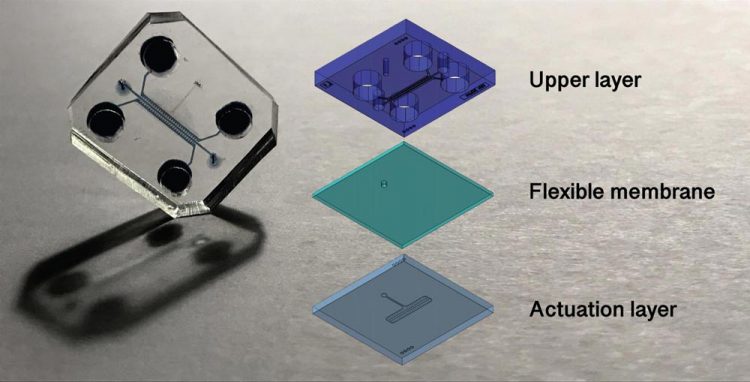Osteoarthritis: A chip 'mimics' the disease to devise effective drugs

A sophisticated chip the size of a coin in which cartilage can be cultivated and which can later be subjected to mechanical stress such that it generates the effects of Osteoarthrosis (OA). Credit: Politecnico di Milano
A sophisticated chip the size of a coin in which cartilage can be cultivated and which can later be subjected to mechanical stress such that it generates the effects of Osteoarthrosis (OA).
This is the extraordinary result achieved at the Politecnico di Milano Laboratory MiMic (Microfluidic and Biomimetic Microsystems) by Marco Rasponi from the Milan-based campus, the study's coordinator alongside Andrea Barbero from the University Hospital of Basel.
The study was published in Nature Biomedical Engineering.
Not only did it produce the revolutionary chip but, while the tiny device was undergoing experimentation, the study also demonstrated that the mechanical hyperstimulation of cartilage seems to be enough to induce Osteoarthrosis-related pathology, without having to turn to administering inflammatory molecules as was common practice up until now.
Indeed, appropriate compression of the cartilaginous tissue can induce typical symptoms of OA: inflammation, hypertrophy and an acceleration of degenerative processes. Therefore, in the cartilage “on a chip” an ideal environment is created in which to test the effectiveness and mechanisms of pharmacological treatments, shortening the timeframes and costs of experimentation while also reducing the need for animal testing.
Osteoarthrosis is the most common among musculoskeletal pathologies. Over the age of sixty, 10% of men and 20% of women will suffer from its effects, numbers which unfortunately are set to increase due to the current rate of population ageing.
However, despite this trend, patients find themselves facing a complete lack of pharmacological therapy, known as DMOADs (Disease modifying Osteoarthritis Drugs): pharmaceuticals, that is, which are capable of not only alleviating the symptoms but also halting or reversing the degenerative processes. In fact, currently the only valid options are palliative treatment or surgery.
The development of effective drugs was hindered by an absence of experimental models that could adequately replicate the pathology.
Up until now the most common approach to reproduce OA in vitro has been based on administering high doses of molecules into cartilage explants, capable of inducing an inflammatory response and some form of catabolism.
Yet the OA obtained in this manner can only partially represent the final symptoms, instead of demonstrating the pathological process in real time. The new chip, on the other hand, uses mechanical stress, representing one of the factors that are most closely connected to the development of OA, and is thus more realistic and more effective in its development and pharmacological screening procedures.
The research will continue towards modelling an entire joint on a chip, thanks to a project initiated by the Cariplo Foundation, having been granted funding following the call for “Biomedical research on age-related diseases 2018”. The project is named “uKNEEque: a 3D microfluidic osteochondral model to investigate mechanisms triggering age-related joint pathologies and therapeutic effects of bioactive factors produced by nasal chondrocytes”. The Politecnico di Milano is coordinating the research with the University Hospital of Basel as a Partner.
Media Contact
All latest news from the category: Health and Medicine
This subject area encompasses research and studies in the field of human medicine.
Among the wide-ranging list of topics covered here are anesthesiology, anatomy, surgery, human genetics, hygiene and environmental medicine, internal medicine, neurology, pharmacology, physiology, urology and dental medicine.
Newest articles

Properties of new materials for microchips
… can now be measured well. Reseachers of Delft University of Technology demonstrated measuring performance properties of ultrathin silicon membranes. Making ever smaller and more powerful chips requires new ultrathin…

Floating solar’s potential
… to support sustainable development by addressing climate, water, and energy goals holistically. A new study published this week in Nature Energy raises the potential for floating solar photovoltaics (FPV)…

Skyrmions move at record speeds
… a step towards the computing of the future. An international research team led by scientists from the CNRS1 has discovered that the magnetic nanobubbles2 known as skyrmions can be…





















